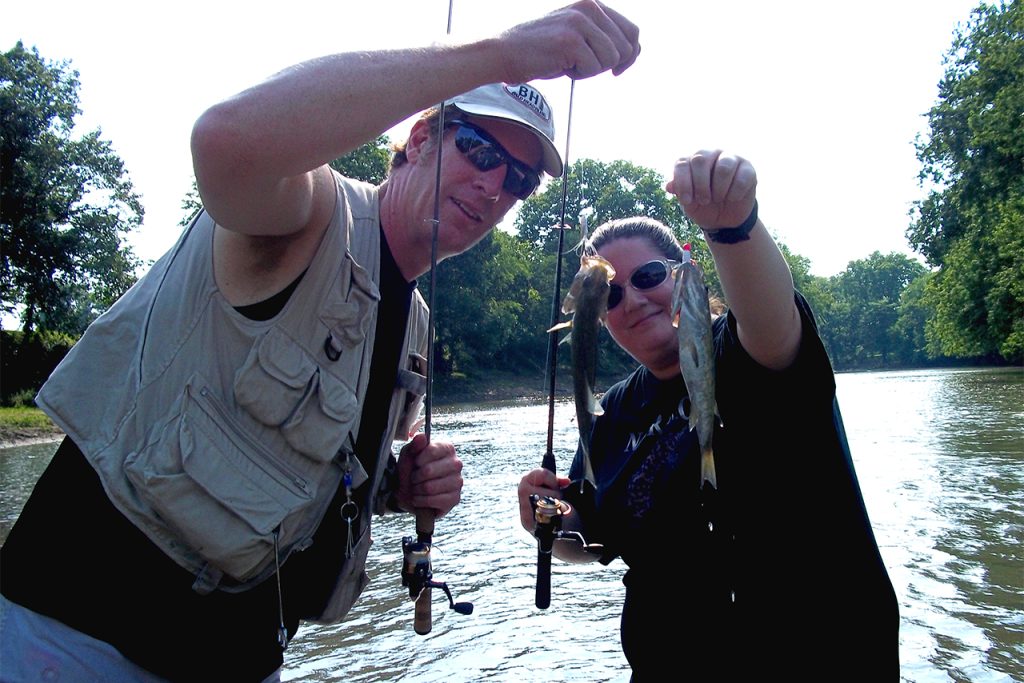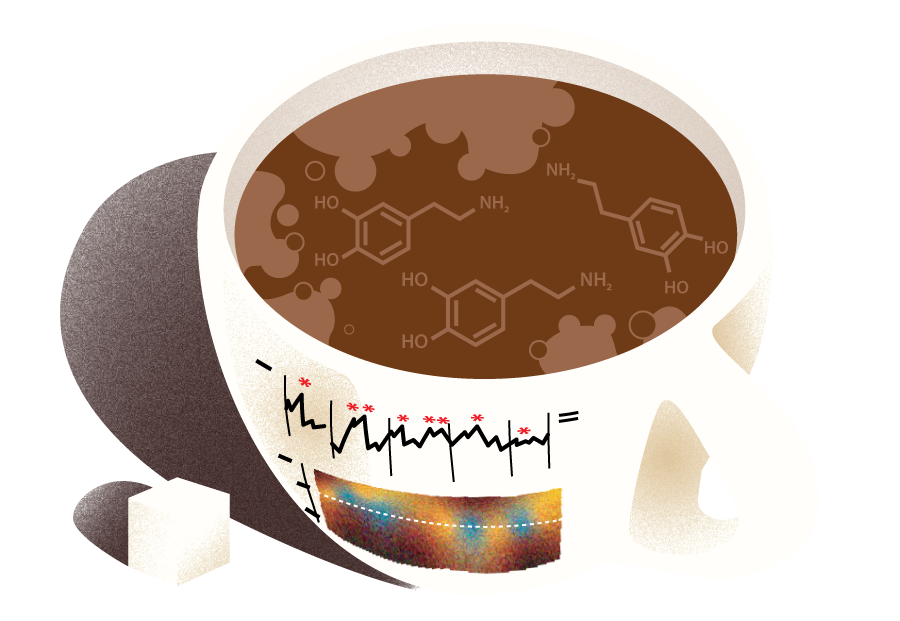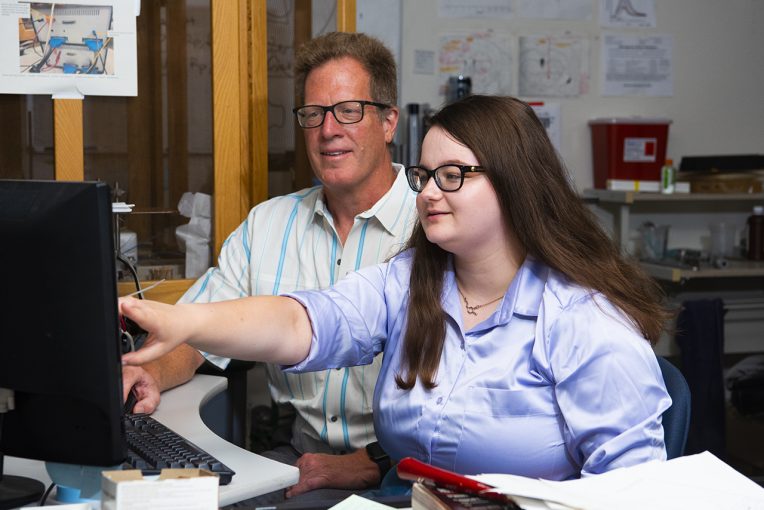Wading through the Vermilion River while gripping a borrowed fishing rod, Dr. Kendra Bunner ’10—a fishing novice—cast her line, felt a tug, and reeled in a smallmouth bass on her first try.
Appears In“It only set me up for disappointment for the rest of the day,” she quipped. Bunner, who was a 20-year-old Illinois State University undergraduate biological sciences major at the time of the fishing expedition, is now a research scientist and lecturer of psychological and brain sciences at Indiana University Bloomington.
Bunner was experiencing her inaugural “Garris lab fishing trip,” an annual daylong adventure in Central Illinois with fellow student scientists from Distinguished Professor of Neurobiology Dr. Paul Garris’ research group.
An avid angler, Garris showed Bunner how and where to cast. After catching and releasing her first and only fish of the day, Bunner watched in awe as Garris reeled in bass after bass.

“He told us, ‘Here’s where you look. See how the water is moving? You want to avoid here and go on that side,’ and then he would instantly catch a fish,” Bunner said. “I think that sums up Paul in some ways. He sees things that other people don’t see—in fishing and in research.”
An Illinois State faculty member since 1995, Garris has investigated the role of dopamine in the brain for nearly three decades, specifically as it relates to Parkinson’s disease and drugs of abuse. Garris has published dozens of journal articles, secured more than $5 million in grant funding, taught thousands of students, and mentored more than a hundred undergraduate and graduate student researchers in his lab. Dozens of those students have earned doctorate or medical degrees and are working in their own labs, mentoring students, and making contributions to the neuroscience field.
The son of a Quaker pastor, Garris grew up in rural Indiana where he spent much of his childhood exploring the outdoors. He loved animals—especially insects and fish—and as a 6-year-old, Garris told his parents he wanted to become a scientist. They bought him a microscope, and Garris’ teachers—from elementary through high school—nurtured his budding scientific mind.
“At some point, we started to learn about how the body works, and I just found it all fascinating,” Garris said. He studied religion and biology at Earlham College in Richmond, Indiana, and pursued a Ph.D. at the Indiana University School of Medicine in Indianapolis.
“In graduate school, I gravitated toward the brain,” Garris said. “Talk about a complicated system. Wow—it’s amazing how it works. The field understands a lot of the nuts and bolts about how the brain works; but how the brain functions on higher levels—I think that’s still largely uncharted territory.”
For his postdoctoral training, Garris researched with University of North Carolina at Chapel Hill Professor of Chemistry Dr. Mark Wightman, an analytical chemist and neuroscientist who had revolutionized techniques for measuring and analyzing dopamine, a messenger within the brain that provides signals about movement, cognition, and motivation. Wightman was an international leader in developing microsensors that could be implanted in lab rats to study dopamine in the forebrain.
“When dopamine neurons dysfunction, you get schizophrenia, Parkinson’s disease, and addiction,” Garris said. “I became so fascinated in that area of research that I’ve followed that direction for my entire career.”
Garris accepted his first teaching job in 1995 at Illinois State. “During my postdoc I realized that I wanted to do teaching and research, and then I found Illinois State where you have the opportunity to do both,” Garris said. “I have really valued the opportunity I’ve had here to pursue both of my academic passions in life.”
Dr. Brian Bergstrom ’97, Ph.D. ’01, professor of biology at Muskingum University in New Concord, Ohio, met Garris as an Illinois State undergraduate student and later became one of Garris’ first graduate assistants. Bergstrom had planned on pursuing a career in secondary science education until he attended a presentation by Garris.
“The work he was doing was fascinating and challenging at the same time,” Bergstrom said. “So I started doing research with him, I took some of his classes, and the rest is history.”
Garris was utilizing implanted microsensors to study Parkinson’s disease, a progressive brain disorder that affects the nervous system and causes tremors, stiffness, and slowing of movement. During the preclinical phase of Parkinson’s, a patient can lose 80% of the dopamine neurons that control key motor functions before ever experiencing symptoms. Garris’ research resulted in a model that explains how the body can continue to function normally to compensate for only 20% of its original dopamine neurons.
Bergstrom assisted Garris with his Parkinson’s research through experimentation and data analysis. They also enjoyed fishing and occasionally worked out solutions to their research problems while casting in a creek.
“Paul never made you feel inferior as a student,” said Bergstrom, a mentor to a half-dozen students who are now faculty members and more than a dozen who are physicians. “It was more like you’re on a journey together. He also taught me about perseverance in research. You face a lot of challenges as a researcher, but you’ll figure it out or something else will come along that’ll help you to understand it.”
Garris’ research gained international prominence. He was invited to collaborate with Mayo Clinic researchers to develop a wireless device that can be implanted in a patient’s brain to measure dopamine and other neurochemical levels during surgery for deep brain stimulation, an established treatment for people with movement disorders such as Parkinson’s disease.
After nearly 15 years of Parkinson’s research, Garris began to shift his focus when a colleague at the Society for Neuroscience conference mentioned that people with methamphetamine addiction will present with a mild case of Parkinson’s. She wondered if Garris’ Parkinson’s research could be applicable to studying amphetamine-induced neurotoxicity.
“In reward learning, dopamine is thought to be a learning signal that teaches us how to find rewards,” Garris said. “Like Pavlov’s dogs—you ring a bell when you present the dogs with food, and then they’ll salivate when they hear the bell. That’s Pavlovian learning, mediated by dopamine.
“There was some really good evidence to suggest that what drugs of abuse do is operate by the same mechanism as natural rewards. They just do it better. Drugs of abuse hijack this important natural learning.”
At the time it was thought that all drugs of abuse hyperactivate dopamine neurons resulting in an increase in brain dopamine levels. However, the exact manner in which dopamine levels are increased by amphetamine was thought to differentiate it from other drugs.
Garris was at the wheel of his Mazda minivan on westbound Interstate 74 one Sunday night, his then 6- and 10-year-old kids asleep in the backseat following a visit to their grandparents’ house in Indiana, when it hit him. “There’s no way that amphetamines act differently,” Garris thought to himself. After he and his wife, Kim, put their kids to bed, Garris immediately began reading journal articles.
While extensive research had concluded that amphetamines acted differently from other drugs of abuse, studies had not utilized advanced microsensors like the ones Garris was operating in his lab. By conducting experiments using these microsensors, Garris and his research group demonstrated that the way amphetamines act to increase dopamine levels is consistent with all other drugs.
Bunner was an undergraduate student researcher in Garris’ lab when the group first successfully detected dopamine in a freely moving lab rat using an implanted microsensor after months of preparation for the amphetamine study. She remembers watching the animal eat a piece of Froot Loops cereal while simultaneously seeing a dopamine peak from the resulting “sugar high” on a nearby computer screen receiving data from the microsensor.

“We were monitoring dopamine changes in real time, and we knew exactly what was causing it and exactly what brain region it was happening in.”
– Dr. Kendra Bunner
“We were monitoring dopamine changes in real time, and we knew exactly what was causing it and exactly what brain region it was happening in,” said Bunner, who drinks hot tea in her office from a mug featuring a screenshot of dopamine peaks detected in Garris’ lab. “Paul was quiet for a moment. Then, he pointed at the screen and said, ‘Yep, there it is.’ It was a very exciting moment for everyone in the lab.”
Understanding how amphetamines act can better inform drug addiction treatment. Garris collaborated with Dr. Pedram Mohseni, associate professor of electrical, computer, and systems engineering at Case Western Reserve University, to develop the concept for a device that could be implanted to suppress the rewarding properties of drugs. When a person takes a drug of abuse, the device would measure the corresponding increase in dopamine, make a calculation, and stimulate an inhibitory input to the dopamine. This type of device would require a chronically implanted electrode for a human, the technology for which doesn’t yet exist.
“So that direction is just sitting there, waiting to be followed up on by someone in the future,” said Garris.
After stepping up to run Illinois State’s SHIELD Illinois coronavirus (COVID-19) testing lab for more than a year, Garris is now wrapping up his research, finishing a few papers, and mentoring his final graduate assistant, Rebecca Chicosky. He plans to retire in spring 2024.
“I came in really not knowing anything about neuroscience,” Chicosky said. “I’ve learned so much from Paul. He kind of overloads you with information, but then you can take that and build on it the more that you’re in the lab and the more that you learn. It’s been amazing.”
In retirement, Garris is looking forward to spending time with his wife, a lab technician who worked in the “Garris lab” for 15 years, and their two adult children, Gaby, a nurse, and Zeke, a mechanical engineer. Garris is also planning to play more volleyball. Last spring, he competed in the USA Volleyball Open National Championship in Orlando, Florida.
And, of course, Garris anticipates frequent fishing trips—some with Garris lab alumni.
“I think it speaks volumes that all of us from the Garris lab still keep in touch,” Bunner said. “They’re some of my closest friends and colleagues.”
Bunner’s first undergraduate mentee is now conducting Parkinson’s research at the Mayo Clinic.
“I was lucky to start off in such a good learning environment,” Bunner said. “And I would like to think that I’m mentoring my students, now, in a way that Dr. Garris mentored me.”


